Key Competencies Kit
for Facing Lifelong Learning


 |
This Project has been funded with support from the European Commission. This communication reflects the views only of the author, and the Commission can not be held responsible for any use which may be made of the information contained therein. |
 |
Upon completion of this Unit you shall be able to:
Most activities that we carry out in our daily life need the intervention of oral language. Providing instructions or conveying and important message, planning an activity, discussing a rumour, judging someone, suggesting a solution to a problem…these are all situations where we must use oral communication (not forgetting other types of communication that were covered in Unit 1).
Moreover, our way of speaking is going to determine, in most cases, the adjectives that other people would use to describe us. Thus, people can be described as prudent, exaggerated, gossiper, polite, and so on.
The act of speaking is so important that, barely noticing it, through this action we are providing information on our thoughts and feelings. Thus, our words go together with different feelings such as love, caring, envy, deprecation, self-pity, acceptance, etc…
In summary, what we say is providing information about what we are, feel and believe, which shall affect our relations with the people around us. For this reason it is important to look after the way that we communicate ourselves orally and using the most suitable communicative resources.
Now that you already know the different types of communication, reflect upon the following questions:
Remember that in Unit 1 we defined Oral Communication as the type of communication that uses spoken words.
A friend explaining to you how to burn a CD, the broadcasting of a football match or a conversation over the phone between two relatives are examples of oral communication.
If you think of any of these examples you shall realize that communication is actually taking place based on the use of spoken words. However, in addition to that…Which other type of elements are being used?
 |
Visit the following link, It is an interview of two famous showman:
Analyze the communication process between these two people. |
In the link provided you have seen that the people involved hold a communication process based in the use of speech, but…Is it based only in the use of speech alone?
For instance, observe where these two people are located, the way they move their hands (especially one of them)…all these aspects are defining certain features of this conversation.
Which adjective would you use to describe this conversation?. Choose some of the adjectives in the following list.
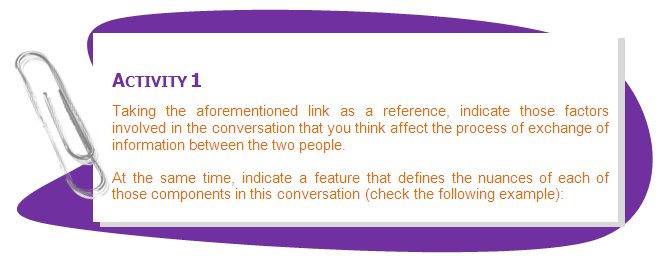
Components of Oral Communication |
|
Voice
|
|
Now that you already know the communication elements that affect the oral transmission of a message, you must take in consideration that:
|
 |
Which is most important in an oral communication process is that all elements involved (voice, stare, gestures, body…) are consistent with the message being conveyed and support the communicative process. |
We already know the elements involved in the oral communication process and we also know that all these elements must be combined in a manner in line with the message being conveyed.
In addition to bearing in mind that we must look after the elements of communication:
|
 |
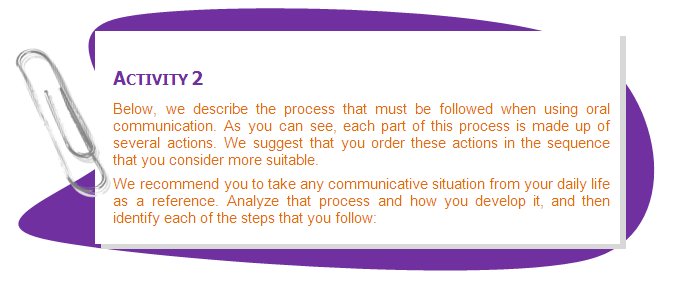
ORAL COMMUNICATION PROCESS |
|
|
Why do I want to communicate it? |
Who am I communicating it to? |
|
What do I want to communicate? |
|
How do I communicate it? |
|
|
|
|
Structuring the message. |
Think of the message that I want to convey, prior to sending it. |
|
Put the ideas in order. |
|
|
|
|
Adapt to the receiver/s of my message (suitable choice of words). |
Look after the elements of oral communication. |
|
 |
Do you communicate in the same way in a conversation with a relative and in a conversation with someone you have just met? Do you use the same style of communication to tell a friend that you have won a prize in the lottery and to tell him that you are sorry for the lost of one relative of his/hers? Which three adjectives would you use to define your style of communication? |
When we are communicating, we change the style of communication or the way in which we communicate. In general, three styles of communication have been established: agressive, inhibited and assertive.

http://www.youtube.com/watch?v=zPkPVxmHmaI&feature=related Analyze the role played by the gunnery sergeant in the movie “A full metal jacket”. |
|
http://www.youtube.com/watch?v=kGm1VwSnsrs Analyze the role played in the communicative process by the male character in the series “Grey´s Anatomy”. |
|
http://www.youtube.com/watch?v=xxP9U1KIh7M&feature=related Analyze the roles placed by the TV anchor and the politician in this interview. |
 |
|
We use different styles of communication. Communication styles can be classified as follows:
|
Depending on the circumstances, we switch between the three styles of communication (aggressive, inhibited and assertive). The assertive style supports the communicative process, as it facilitates the transfer of information and avoids conflicts. |
 |

The teacher shall give each of you a card indicating the style of communication that each of you is to be using in this activity (aggressive, inhibited or assertive). You must play the role indicated on the card and the rest of peers must find out which style of communication is being used.
In order to practice each of the styles of communication, the whole group shall start a debate on the following subject:
What do you think of the overwhelming amount of advertising being broadcasted by the mass media (TV, radio, press, Internet…)?
You can devote 20 minutes to discuss this matter. Everyone must give his/her opinion, explain his/her arguments, justify your ideas, etc.
When the time devoted to the debate finishes, and bearing in mind the style of communication used by each of you, you must work together and try to find out which style has been assigned to each member of the group.
 |
|
Most surely, you often have a good time chatting with your friends, relatives, acquaintances, etc. By means of a conversation we express our thoughts and feelings and we make petitions…
Conversation is one of the mostly used manners of communication. In spite of its being a spontaneous and day-to-day activity, we don’t always carry it out in the best way.
Conversation is an oral communication activity where several people alternate the roles of sender and receiver and negotiate the sense of the statements. |
Below we suggest a series of principles related with conversation. You have to opposite options, you must choose the option that you consider more suitable to support the communicative process:
A conversation is developed properly if... |
|
Everyone involved takes part in it. |
Just one person of those involved takes part in the conversation. |
Everyone involved make clear what they think. |
Just one person makes clear what he/she thinks, and tries to win over the other people. |
The parts involved must confront one another whenever possible. |
The parts involved must work together and provide the necessary information. |
The information conveyed in the conversation must be confusing and untrue. |
The information conveyed in the conversation must be clear and true. |
If you have reflected upon the characteristics of a proper conversation you probably have realized that in order for the conversation to be properly conducted it is necessary:
|

If you analyze your answers to the previous questions, you can realize that when we talk we follow a process:
|
If we should conduct a survey on the most common fears that affect people, we would find out that speaking in public is one of them.
Few among us shall have to face an audience of millions of people as TV anchors do, however, probably, along our life, sooner or later, we shall have to address a large group of people. If you have already experienced such a situation, you probably know that this is not at all easy: we are afraid of the ridicule, of criticism, of being made fun of or of any other circumstance that makes us feel embarrassed.
 |
Clicking on the link below you can view the moment when the actress Penélope Cruz received the Academy award for best supporting actress (2009):
Analyze the elements of verbal and non-verbal communication that you already know and answer the following questions:
Which do you think is the reason for the changes in the voice volume?
Why do you think that she speaks so fast?
Where is the staring at?
|
As you have seen, when speaking in public, the importance of all elements of communication, both verbal and non-verbal, increases.
If we analyze the elements of communication when Penélope Cruz is speaking in public, we can understand the emotions that she is feeling in that very moment.
When speaking in public we must be especially careful with the following aspects: the voice (pitch22, volume, pronunciation…), facial expression, the stare, the subject being discussed and the physical appearance. |
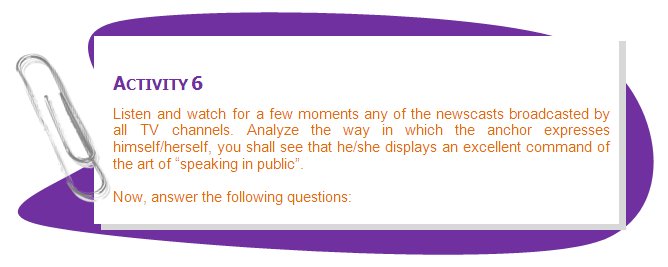
How is the pitch of the voice?. Is it low or high?. Does the pitch of the voice reflect self-confidence or lack of self-confidence?
How is the pronunciation?. Is his speech clearly understood?
Does he keep a steady stare at the camera?. Does he seem focused or distracted?
Does he make gestures with his face?. Does the facial expression reflect feelings or thoughts?
Does the vocabularythat he uses show a good command of the subject?. Can you feel that he´s familiar with the subject he´s talking about?
Is his physical appearance(clothes, accessories, hairdo, etc…), appropriate?, Does it call too much of attention?
News anchors are an excellent example of people that have an excellent command of the skill of speaking in public.
When speaking in public you must be especially careful with the following aspects:
|
When speaking in public it is very important to be especially careful in choosing the first and last sentence. We must catch the attention of our audience right from the beginning and finish our speech leaving a good sensation. |
 |
Analyze the situation depicted in the picture below.
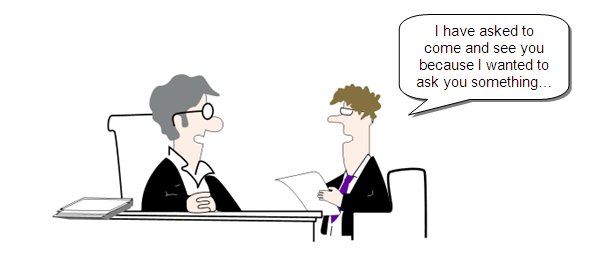
Probably, in more than one occasion you had to express a rather complicated petition or demand, like the one depicted on this image and you have missed some key skills.
We want you to imagine that you are in the place of the person that is expressing the petition in the previous situation:
Do you think it would be easy?
What difficulties would you find?
How would you formulate your petition?
We are all entitled to ask for what we want, as long as we don’t violate the rights of others; however, not all of us have the key skills to do it in the best way.
Now, we want you to imagine that you are in the place of the person receiving the petition and to answer the following questions:
What would you think if the person that is asking for a raise should not make eye contact with you?
And if he/she should be speaking in such a low voice that you could hardly hear him/her?
Imagine that the person asking for the raise is nervously biting his/her nails. What would you think of this?
Which expression would you rather hear?. Choose one of these two options:
When you have to formulate a petition, it is important that you follow the following guidelines:
|
Very often, formulating petition is as hard, as rejecting them.
Saying “NO” to a friend who is asking us for a personal favour, is asking for help or formulating a petition can become a rather complicated task.
In order to understand the difficulty of communicating negative answers, we shall refer again to the situation aforementioned.
Analyze how the communicative process seen in the previous section continues:
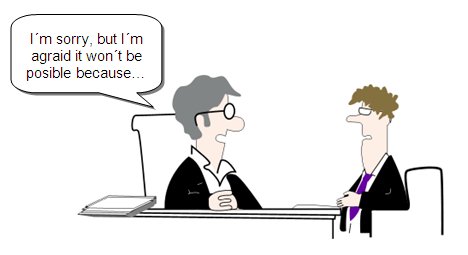
As you can see, the boss rejects the petition formulated by the employee.
As a matter of fact, the boss has the right to say “NO” to the worker's petition.
All people have the right to say “NO”, whenever we want to do so, and there is no reason to feel bad about it. It is our right to answer “no” to petitions that are not reasonable and to those petitions that we are not willing or able to accept.
Let's imagine that the boss rejects the worker's petition because, at that time, due to the financial situation of the company, it is impossible to assume further costs. The boss feels sorry about having to reject the petition, but nevertheless, he must do it in the most suitable way.
Now, imagine you are the worker and answer the following questions:
What would you do if your boss stars the conversation looking down and saying he is sorry?
What if he stars the conversation saying something like: “How dare you!”, “No way”, “You don´t deserve…”?
What if he stars beating around the bush, but he does not make it clear whether he accepts or rejects your petition?
What would you prefer that your boss should tell you? Choose one of these two options:
“When you were hired, you signed certain financial conditions that won't be negotiated again now”.
If you reflect upon how you would express your rejection to a worker, you shall realize that there are several criteria that make this task easier.
When communicating a rejection you must bear in mind the following guidelines:
|
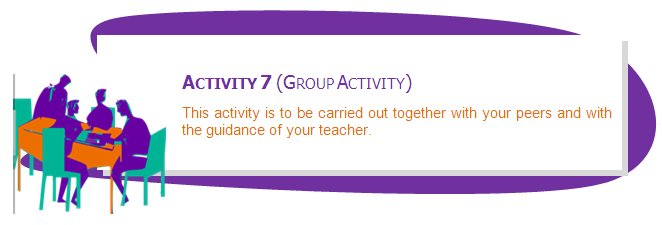
As you already know, saying “no” may be more complicated than it seems, especially in those situations where we feel under pressure. There are several useful techniques that can be used to make this easier.
Your teacher shall briefly explain the Broken Record Technique that is based on repeating once and again what we want, always displaying good manners and respect.
The group shall be divided up in pairs, each pair must represent a situation where it is hard to say “no”. In order to solve the situation, one member of the pair must use the Broken Record Technique. The rest of the group shall analyze the situation and discuss whether using such technique helps to solve the problem.
To make this activity clearer, we provide an example of how Alberto is using the Broken Record Technique:
 |
Do you think that this technique might be useful with really insistent people?
How would you feel using this technique?
How about if other people use it with you?
|
 |
You have a right to say “no”, but you must always do it displaying good manners and respect. |
When we are communicating with someone else, we usually find out that we think differently to other people. In such cases:
You probably understand that the best alternative is the third one; however, it is also possible that most times we tend to choose the first option, or even the second one.
Everyone has a right to express freely their personal preferences, to position themselves in any matter or to express an opinion disagreeing with other people.
Expressing our opinions is not always easy, as we run the risk of being misunderstood or that our ideas are wrongly transmitted. However, even if it is difficult to some extent, it does not mean that it is impossible.
When we have to express our opinions, it is useful to:
|
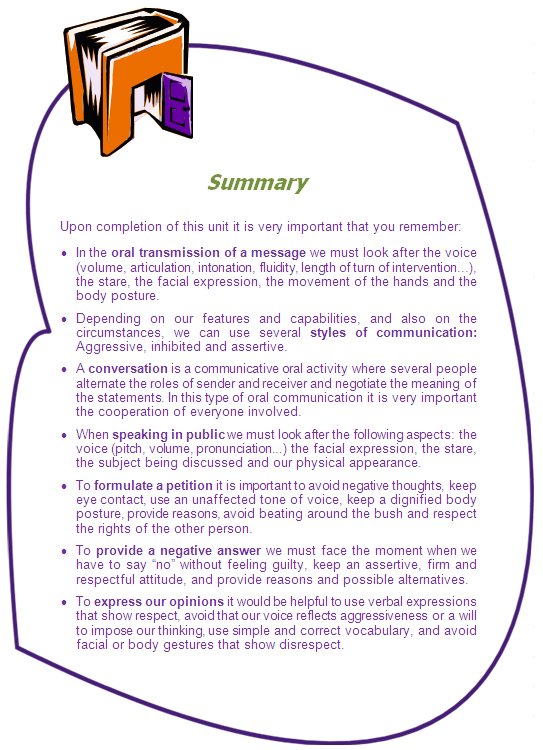
 |
Response to issues and activities outlined in the Didactic Unit 2 |
In the link provided you can see an interview conducted by A. with B.. In this interview we can see the following:
Oral Communication Components |
|
The voice Volume: Appropriate and steady (except at certain points, for example, when the interviewed does an impersonation, makes jokes, etc.). Articulation: Appropriate on both cases. The words are perfectly understood. Intonation: Appropriate for the voice, without any inappropriate intonations. Fluidity: Smooth, especially in the interventions of the interviewed (who speaks very fast). Length of turn: There is a proportionate ratio between interviewer and interviewed. At some points the turns of the interviewed become longer. |
The stare: Interviewed and interviewer constantly keep eye contact, except for some times when the interviewed seems to address the audience. Facial expression: Supports the message, especially in the case of the interviewed (sometimes, it really helps to understand perfectly the message). Motion of the hands: The interviewed moves his hands constantly and too much. Body posture: Relaxed (especially in the case of the interviewed) Distribution in space: the interviewer is in a higher place than the interviewed (the interviewer is setting the pace of communication). |
The process that we must follow when using oral communication is made up of the following steps. You shall see that the appropriate sequence is:
In the analysis of the situation: c, b, a and d.
In the preparation of the communicative situation: c, a and b.
In the formulation of the message: a and b.
The correct relationships are: A (1, 3 and 5), B (2, 4 and 7) y C (6, 8 and 9).
Below we suggest an example of conversation that might be similar to the one you have described:
How did you start the conversation?
For example: Hello, How are you doing?
How have you started to discuss the main topic of the conversation?
For example: - Yesterday, I walked into your sister and she told me that you are preparing yourself to get your driving licence.
How long have you been exchanging opinions?. Summarize what you said and what the other person said.
For example. During 3 minutes. I said that I also wanted to get me a driving licence soon; the other person told me that he/she had already tried twice, but that, this time, he/she would succeed.
How have you closed the conversation?
For example: - Well, see you soon. Take care.
Analyzing the way the news anchor communicates, you might have noticed some of the following details.
The pitch of the voice is higher, but moderate and steady. It reflects self-confidence on the information he is communicating.
The pronunciation of words is appropriate, which makes it easier to understand the message.
The anchor constantly stares straight into the camera, (addressing the viewers) showing that he/she is focused on the communicative process.
The facial expression is utterly neutral, and it supports the information being sent, (the information is transmitted exactly as it happened).
The vocabulary is direct and simple, it shows a command on the subject and it makes it easier for the viewers to understand.
The physical appearance has been looked after and it does not include any element that might distract the viewers attention, (that must focus on the information being sent).